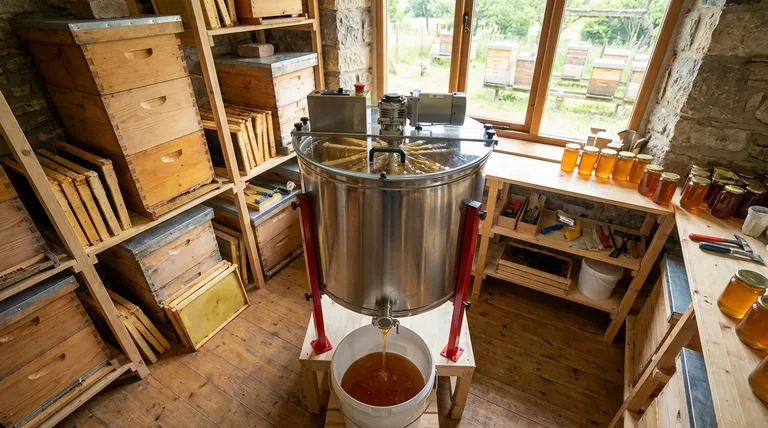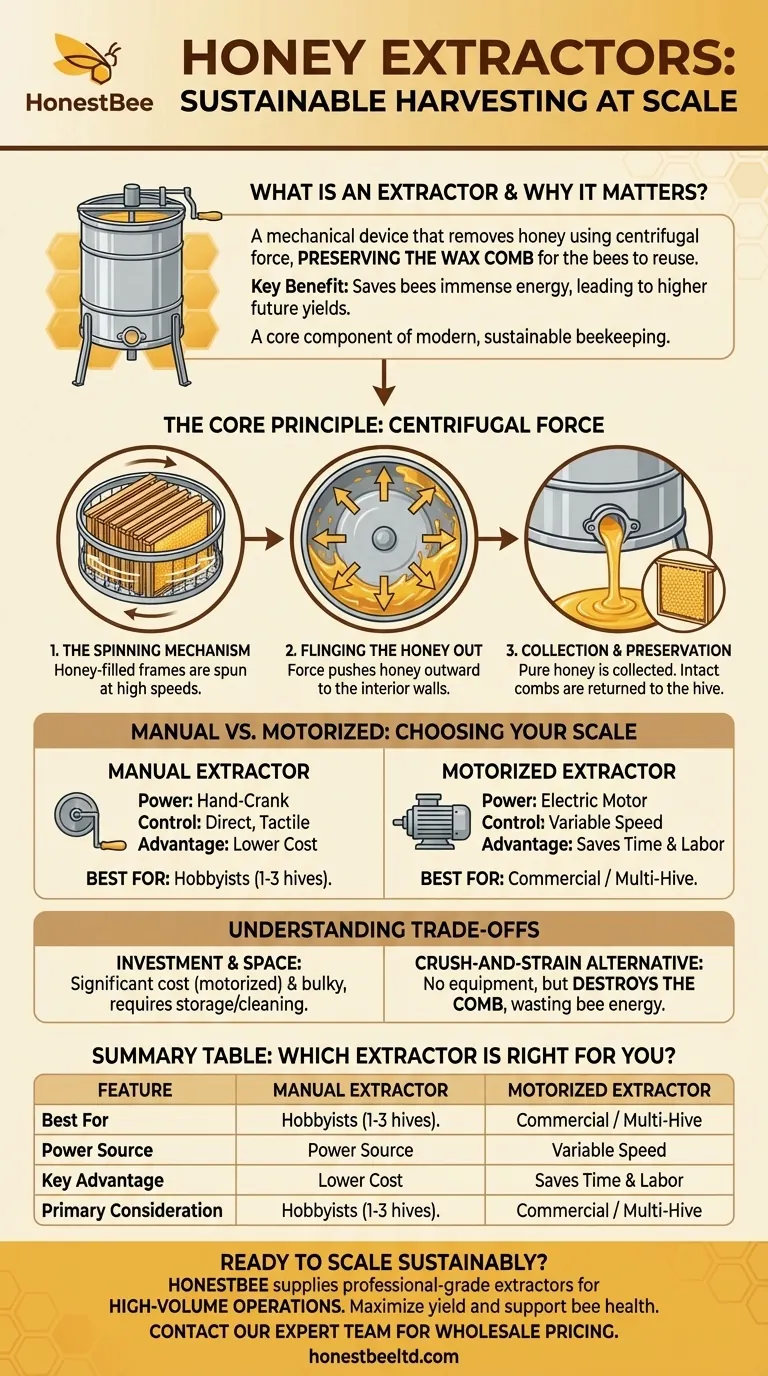In beekeeping, a honey extractor is a mechanical device that removes honey from the honeycomb without destroying the comb itself. It operates using centrifugal force; a basket inside a large drum spins the honey-filled frames, flinging the honey out against the walls where it can be collected. This process is central to modern honey harvesting because it allows the beekeeper to return the empty, intact wax combs to the hive for the bees to reuse.
The core value of a honey extractor lies not just in its efficiency but in its sustainability. By preserving the delicate wax comb, it saves the bee colony an immense amount of energy and resources, which can then be redirected toward producing more honey.

The Core Principle: Centrifugal Force in the Hive
A honey extractor is a simple yet brilliant application of physics designed to work in harmony with the bees' natural product. The entire process is built around separating the liquid honey from the solid wax comb gently and efficiently.
The Spinning Mechanism
At the heart of any extractor is a frame basket housed within a stainless steel drum. After the beekeeper slices the wax cappings off the honeycomb cells, the frames are placed in the basket. As the basket spins, it generates powerful centrifugal force.
Flinging the Honey Out
This force pushes the liquid honey outward from the cells of the comb. The honey hits the interior wall of the drum, runs down to the bottom, and collects there. A spigot or gate at the bottom of the drum allows the beekeeper to drain the pure, filtered honey.
The Importance of Preserving the Comb
Producing wax is one of the most energy-intensive tasks for a honeybee. By keeping the comb intact, the extractor allows bees to immediately begin refilling it with nectar. This dramatically increases the potential honey yield for a colony over a season compared to methods that require the bees to rebuild the comb from scratch.
Manual vs. Motorized Extractors
The fundamental principle remains the same, but the power source creates a key distinction between extractor types, catering to beekeepers of different scales.
The Hand-Crank Extractor
Manual extractors are powered by a hand-crank. They give the beekeeper direct, tactile control over the spinning speed. This type is generally less expensive and is an excellent choice for hobbyists with only a few hives.
The Motorized Advantage
Motorized extractors use an electric motor to spin the basket, often with variable speed control. This significantly reduces the physical labor and time required for harvesting, making it the standard choice for beekeepers with multiple hives or those running a commercial operation.
Understanding the Trade-offs
While an extractor is a vital piece of equipment for many beekeepers, it's important to understand the associated considerations.
The Initial Investment
Honey extractors represent a significant financial investment, especially motorized models. For a beginner with a single hive, the cost can be a considerable barrier to entry.
Space and Maintenance
These devices are bulky and require adequate storage space. More importantly, they must be meticulously cleaned and sanitized after each use to prevent the spread of bee diseases and to ensure the honey remains pure.
The Crush-and-Strain Alternative
The primary alternative to extraction is the "crush and strain" method. This involves mashing the entire honeycomb and straining the honey through a filter. While it requires no special equipment, this method completely destroys the comb, forcing the bees to expend valuable resources rebuilding it.
Making the Right Choice for Your Goal
Selecting an extractor depends entirely on the scale and ambition of your beekeeping operation.
- If your primary focus is a small-scale hobby (1-3 hives): A simple, manual 2-frame or 3-frame extractor is the most practical and cost-effective choice.
- If you are growing your operation (4+ hives): A motorized extractor will save you an immense amount of time and labor, quickly justifying the higher upfront cost.
- If your primary focus is bee health and sustainability: Using any type of extractor is vastly superior to the crush-and-strain method, as it supports the bees' natural workflow and conserves their energy.
Ultimately, the honey extractor is the tool that transforms honey harvesting from a destructive process into a sustainable and efficient one.
Summary Table:
| Feature | Manual Extractor | Motorized Extractor |
|---|---|---|
| Best For | Hobbyists (1-3 hives) | Commercial / Multi-hive Operations |
| Power Source | Hand-crank | Electric Motor |
| Key Advantage | Lower cost, tactile control | Saves time and labor |
| Primary Consideration | Physical effort required | Higher initial investment |
Ready to scale your honey production sustainably?
For commercial apiaries and beekeeping equipment distributors, efficiency and bee health are paramount. HONESTBEE supplies professional-grade, durable honey extractors designed for high-volume, wholesale-focused operations. Our equipment helps you maximize honey yield while supporting the vital work of your bees.
Contact our expert team today to discuss wholesale pricing and find the perfect extraction solution for your business.
Visual Guide

Related Products
- Electric 8 Frame Honey Spinner Extractor Equipment for Beekeeping
- HONESTBEE 72 Frame Industrial Electric Honey Extractor for Beekeeping
- HONESTBEE 3-Frame Manual Acrylic Honey Extractor
- 2 Frame Stainless Steel Manual Honey Spinner Extractor for Beekeeping
- 8-Frame Electric Self-Reversing Honey Extractor Spinner for Commercial Honey Extraction Equipment
People Also Ask
- How long should you spin honey? Master the Art of Efficient, Damage-Free Extraction
- What equipment is needed for extracting honey? A Complete Guide for Every Beekeeper
- What should be considered when harvesting honey from multiple hives? Scale Your Harvest Efficiently
- Why is cleaning a honey extractor important in beekeeping? Protect Your Honey Quality & Equipment
- What machines are needed in beekeeping besides basic tools? Scale Your Honey Harvest Efficiently



















